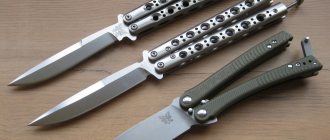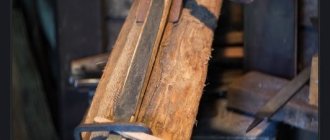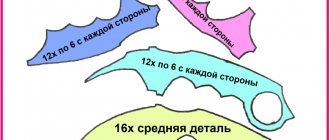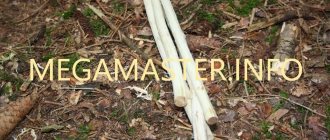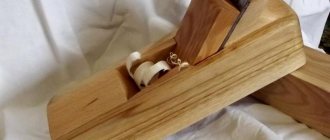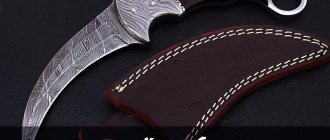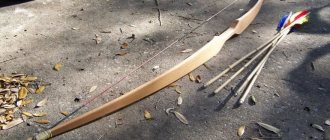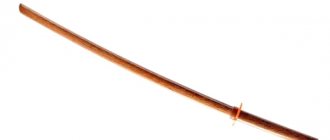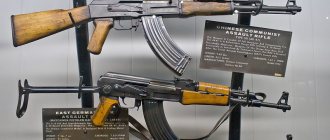09/10/2015 Legendary Nepalese kukri knife
Tweet
Knives are the favorite toys of men at all times, a testament to their strength and courage! This is a hunting knife, a stiletto, a scimitar, a Roman sword, and a machete. But there is one among them that is not like all the others. This is kukri . Heavy, massive, durable, well balanced, which can be used in close combat, cut a path in the jungle and even shave.
The Kukri is a blade that is the stuff of legends. Many of the bladed weapons have long become museum exhibits, and the ancient kukri is still in service with the army: 600 grams and 15 inches long with a handle - the military standard of the Nepalese Ministry of Defense.
And the old national emblem of Nepal, which existed until 2006, depicts crossed kukris as a symbol of the Gurkha army.
There is no consensus on the correct name for this knife. The two most common spellings are: kukri and khukri, they are equal, so do not be surprised if one or the other appears in the text.
Elements of a kukri knife
All knives have a blade and a handle. But each has its own differences and characteristics.
Kukri Blade:
- The downward curve is not the only feature. The blade has a triangular cross-section.
- An interesting solution is that the hardening of the blade has different values; the cutting edge has a higher value than the value closer to the butt.
- Sharpening is done only from the inside, but it is with a variable angle. This allows the knife to be used for stabbing, chopping, and cutting. Kukri is a universal instrument.
- There is a dol on the blade. Experts say that it is made to improve shock absorption during slashing or blows with a butt.
- There is a notch made near the handle, it is called cho. It comes in different forms, but the essence is the same. The function of this is to protect the blade from chipping. Similar knives without cho, manufactured on the American continent, break at the handle when chopping on hard material.
- The material used to make the handle is water buffalo horn or rosewood. Rings are made on it for better fixation in the hand. Even a wet hand does not slip.
- The metal cap at the end of the handle allows it to be used as a hammer.
Kukri: design.
Why is Shiva's tooth on a knife?
In Nepal, it is believed that if a kukri is taken out, it should be stained with blood. This belief kept its owner from taking rash steps. Shiva's tooth served to prick the finger and lubricate the blade with blood before sheathing it.
Is it foldable?
Folding kukri is used as a souvenir, during hiking or fishing as a handy tool. In this case, the blade is made entirely of high-carbon steel and the ratio of the length of the blade to the handle is non-classical. It cannot be used as a military weapon.
Possession technique
The knife can be held with both hands or with one. The hand with the knife is slightly raised and pulled back. The grip is made with the entire palm on top of the handle, as close to the blade as possible. All this is due to the fact that the blows with this knife are chopping.
This is where the general rules end.
Blows can also be delivered with a handle that ends in a metal cap. Each kukri owner has an individual technique for owning it. In Nepal, no one was specifically developing it.
Machete in culture and art
This weapon is very popular in the film industry. Popular in horror films for cutting off limbs (Friday the 13th, Jason X). It is often used in action films, for example, the famous film with Arnold Schwarzenegger - “Commando”. There is a film that is almost an advertisement for a knife - “Machete” with Danny Trejo in the title role, where he chops his enemies left and right with a large cleaver.
Previous
KnivesGrower's grafting knife: types, selection rules, sharpening
Next
Ancient HOSeppuku - what is it and how does it differ from hara-kiri
Kukri knife drawings with dimensions
This knife has slight variations, but the basics are the same. A drawing of the classic version of kukri is presented in this material.
How to sketch a knife
For the sketch, take thick cardboard or thin plywood. The drawing is transferred with all the details and the pattern is cut out.
Kukri: drawing with dimensions.
History of origin
There is no exact information about the origin of the Nepalese blade. The curved knives are strongly reminiscent of the Greek copis or Spanish falcata swords. Perhaps local craftsmen adopted the technology during the arrival of the army of Alexander the Great in Nepal. Historians and experts on the country's relics say the opposite.
According to other versions of the origin of this blade, its prototypes were the Turkish scimitar or the Etruscan mahaira, reduced several times.
The Turkish scimitar is a prototype of the Kukri knife.
Written evidence of a machete-like blade dates back to the 7th century. The most valuable specimens are considered to be items from the 14th century.
Europeans became acquainted with the power of these knives during the British colonization of Nepal. The British were amazed by the fighting qualities of the edged weapons of the aborigines, which cut off a man’s head with one blow.
There is still debate among antique dealers and experts about what to call this weapon in Russian. Experts in the Nepali dialect claim that the correct name for the knife is “khukri,” but the name “kukri” is more familiar to Russian ears.
Step-by-step instructions for making Kukri
Step-by-step instructions are needed to understand the sequence of actions. If you follow this algorithm, you get a predictable result:
- We apply a pattern to the selected piece of material. We make an overlap along the contour of 5 mm, it makes it possible to later process all the edges with a file and get the desired size.
- Using a sharp tool, preferably with an ebonite tip, the contour is applied.
- A blank is cut along the outlined contour. It is possible to use a grinder.
- The blank is heated red-hot and forged with a hammer weighing 3 kg. In this way the blade and tang are formed. The process lasts about 30 minutes, so it is better to do it together.
- During this time, the metal will cool and become dark. It's time to heat it up again and beat 1.5 kg with a hammer. During the process, it is advisable to constantly change surfaces so that the processing proceeds evenly.
- The dol is formed using a metal rod. It is pressed against the blade blank and beaten with a light hammer.
- Water is poured onto the hot blade of the almost finished workpiece. It should be cold and flow in a thin stream onto a strip of metal along the cutting edge. This is how zone hardening is done - periodically heating the workpiece and pouring cold water on it.
- The resulting workpiece is processed with a file and sanded with fine sandpaper. The polishing process is carried out using genuine leather.
- The handle is made of wood and is mounted on a shank; fastening occurs with glue.
- A metal cap is put on the end of the handle and secured with a nut to the shank.
Kukri knife.
Economic use
Many tourists are interested in what a kukri knife is for. Residents of Nepal use it not only in battle. For peasants, this knife often replaces an ax or machete. They use it to cut sugar cane, vines and bamboo stalks to build huts. Hunters clear paths in the jungle for them. But for economic purposes, only simple models that have no sacred meaning are used. A real combat knife is never used for this.
Souvenir kukri, which are sold to tourists in shops in Nepal, are low-quality products intended to be hung on the wall.
They should not be used for work, as the material they are made of is too soft, and the handles quickly fall off. The knives used in the army and police are made of much higher quality.
Modern manufacturers produce all-metal knives. Their handles are equipped with overlays made of wood or horn. Although these products are not traditional, they are more reliable and can be used for household purposes. Folding kukri models are also very convenient.
According to GOST, used in the Russian Federation, a kukri knife cannot be considered a bladed weapon. This is explained by the fact that the deflection of its butt is more than 15 mm, and the angle of the blade tip is more than 70 degrees. Legislation classifies such knives as household knives, since they are not suitable for stabbing.
The kukri knife is a weapon of ancient history, the configuration of which has been tested for centuries. It is designed to deliver powerful chopping blows, which is facilitated by the special shape of the cutting edge of the blade.
The Nepalese army is armed with kukri combat knives, and their economic varieties are widely used by local residents for domestic purposes.
DIY kukri sheath
There are two common sheath options:
- Wooden scabbard. They are created from thin wooden dies and fastened with leather strips.
- Leather scabbard. Of course, such sheaths are made from genuine leather.
The first option is easier. The skin is soaked in water and tightly applied to the knife. Usually, the sheath includes not only the blade, but also part of the handle. The skin is given time to dry without the use of heat.
The second method is more difficult:
- First you need to make a template from thick paper or oilcloth.
- The knife is applied to the material.
- The outline of the blade and part of the handle is outlined.
- Allowances are added and the layout is assembled.
- It is measured on a knife and then the leather is cut out using ready-made patterns.
If additional pockets or fastenings are required, they are made later. The pockets are sewn on before the sheath is sewn together.
Sewing a holster
The scabbard can be sewn or fastened with rivets. They are sewn together with either thick reinforced thread or a leather strip. After securing the edges, the excess material needs to be cut off to make the sheath look better.
Depending on your wishes, it is possible to apply a design on their surface.
Belt loop
If a sheath is needed, a hole is made for a belt loop or belt. We recommend trying it on in place first and then making holes.
Description
A machete is a long, thin and wide knife with a one-sided sharpening. The blade is convex, sometimes slightly curved. The length is often more than 50 centimeters with a butt thickness of up to 3 mm.
At its core, it is an agricultural tool in Latin America and in the tropics for harvesting cane and cutting down bunches of bananas.
And also, it has long established itself among the “conquerors of the jungle” for cutting through vines and other vegetation along the way. Moreover, each country has a number of features that make the weapon unique.
Product modifications
The usual length of the blade ranges from 200 to 400 mm, the thickness of the butt is from 8 to 12 mm. The knife is sharpened with a variable angle, thanks to which its cutting part can be used for cutting, planing, dissecting, and chopping.
In Nepal you can see various modifications of the knife, which differ in the shape of the blade and handle, weight and size. This is explained by the fact that kukris have different purposes. The following types of products are manufactured:
- ritual;
- souvenirs;
- economic;
- combat.
Local blacksmith schools make kukri of various shapes and weights. Carbon steel, obtained from railway equipment and decommissioned rails, was previously used as a material for making blades. Nowadays, blacksmiths use springs from buses and trucks. German products are in particular demand, less often - Japanese ones. Making kukri has the following nuances:
- Weapons are produced using ancient technology using hand forging. Hammers are often involved in its production.
- Zone hardening of the blade allows you to increase its strength and give it excellent cutting characteristics. The body of the blade is hardened to HRC 35-48, near the cutting edge - to HRC 56-58.
- The blade has the smallest sharpening at the handle, and the greatest sharpening in the middle part.
- There are two types of dols - chirra (wide and shallow) and khol (narrower and deeper). The first passes near the cutting edge, the second - near the butt. In large-sized antique products, the hall notch made it possible to reduce the weight of the blade.
- The handle of a traditional kukri used to be made of horn or precious wood. Usually it was mounted, less often - plate-shaped, fastened with rivets. Many surviving ancient specimens are equipped with items made of ivory or rhinoceros horn. Currently, brass, expensive hard wood, and aluminum alloys are used for this purpose. On inexpensive models, the handles are made of rubber-like plastic with an anti-slip treatment.
- The scabbard of an ancient combat knife was made of wood, covered with leather. They contained two more knives of a similar shape, but smaller in size. One small kukri was used for household work, the other was very hard and had a rough surface. It was used to light a fire and straighten the blade of a combat knife. Modern army kukris do not have additional knives.
Leather
The easiest way to make your own is a leather sheath. Material: saddle leather or rawhide. They are easy to process and retain their shape. The stitching ensures a tight fit between the edges. This can be done with an awl or with an overlocker.
For this type of sheath you will need the following materials and tools:
- Awl or overlocker. If this is a one-time production, you can stop at an awl.
- Thread up to 0.7 mm thick. It is treated with paraffin for better glide.
- Glue and thinner. The seam is treated with this composition so that the case for the folding knife has maximum tightness and reliability.
- Felt liner. An alternative is to install a plastic insert.
